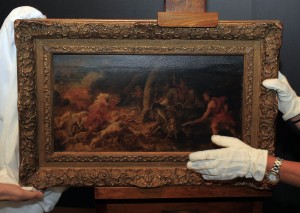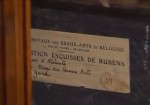 Ten years ago, three masked men broke into the Fine Arts Museum of Ghent in Belgium and tore two works by Flemish Old Master Peter Paul Rubens off the wall. While beating a hasty retreat, they dropped one of them, “The Flagellation of Christ,” but made away with “The Calydonian Boar Hunt.”
Ten years ago, three masked men broke into the Fine Arts Museum of Ghent in Belgium and tore two works by Flemish Old Master Peter Paul Rubens off the wall. While beating a hasty retreat, they dropped one of them, “The Flagellation of Christ,” but made away with “The Calydonian Boar Hunt.”
They picked the wrong piece to be clumsy with because as it happens, “The Flagellation of Christ” is a 1614 preparatory oil sketch for a painting that is part of an important series made by 11 luminaries of 17th century Flemish art like Rubens and Antony van Dyck. The completed painting is in St. Paul’s Church in Antwerp, but even the sketch is extremely significant because it shows Rubens’ process and because he himself gave great importance to his sketches, keeping them until his death. It’s far more valuable that “The Calydonian Boar Hunt” which is a common theme that Rubens returned to often.
 Still, they managed to steal at least one Rubens and even if it only garnered them a few hundred thousand dollars rather the millions “The Flagellation of Christ” is worth, that’s an entirely respectable payday for butterfingered burglars. Of course, you actually need to sell it to make any money at all. Fast-forward ten years and Athens police get a tip that two people are trying to sell a Rubens stolen from a Belgian museum 10 years ago. On Thursday, September 1, police set up a sting operation during which one women — a 40-year-old Greek TV host — and one man, a 65-year-old former antique store owner — attempt sell the painting to undercover officers for six million euros ($8.4 million).
Still, they managed to steal at least one Rubens and even if it only garnered them a few hundred thousand dollars rather the millions “The Flagellation of Christ” is worth, that’s an entirely respectable payday for butterfingered burglars. Of course, you actually need to sell it to make any money at all. Fast-forward ten years and Athens police get a tip that two people are trying to sell a Rubens stolen from a Belgian museum 10 years ago. On Thursday, September 1, police set up a sting operation during which one women — a 40-year-old Greek TV host — and one man, a 65-year-old former antique store owner — attempt sell the painting to undercover officers for six million euros ($8.4 million).
 The couple are arrested, loudly declaiming their innocence. The woman received it from an Italian lover in 2003, she says. He told her it was a copy, she says. She insists neither she nor her antiquarian accomplice had any idea it was a real Rubens or any idea that it was stolen. There’s a wee problem with this story, though. These doofuses left the “SKETCH BY RUBENS – PROPERTY OF FINE ART MUSEUM OF GHENT” label on the back of the painting. Greek National Art Gallery director Marina Lambraki-Plaka described this crack crew best: “amateurs — unless they had some other reason for keeping the identification details on the back of the painting.”
The couple are arrested, loudly declaiming their innocence. The woman received it from an Italian lover in 2003, she says. He told her it was a copy, she says. She insists neither she nor her antiquarian accomplice had any idea it was a real Rubens or any idea that it was stolen. There’s a wee problem with this story, though. These doofuses left the “SKETCH BY RUBENS – PROPERTY OF FINE ART MUSEUM OF GHENT” label on the back of the painting. Greek National Art Gallery director Marina Lambraki-Plaka described this crack crew best: “amateurs — unless they had some other reason for keeping the identification details on the back of the painting.”
But wait! There’s more! It turns out the painting probably isn’t a Rubens at all. Since its theft, museum experts have reevaluated its provenance and think it’s more likely a copy, the handiwork of one of his students based on the master’s design. It’s like a Guy de Maupassant story, I swear.
The couple have been arrested and charged with attempted money-laundering. Authorities don’t think they were involved with the theft at this point and they’ve released them on bail with a travel ban. Belgium hasn’t filed the official reclamation paperwork yet, but the Belgian ambassador to Greece announced that the Ghent museum will be delighted to have their Rubens-ish painting back and that they will proceed with the business through normal diplomatic channels.
They really are not very bright and they have the worst defence ever claiming they thought it was a copy. If that’s the case why did they think they could sell it for $8million. 😆
This art theft story has a happier ending than most. The purloined art returns home and we have some good clean fun along the way. (“But Madame, the diamond necklace was paste!”) Although we could have had a hell of a lot more fun, had the Getty Museum bought the “Calydonian Boar Hunt”. In the made-for-TV-special, can I play the Greek TV Host’s not necessarily phantasmic Italian Lover? (Oh, please!)
This brings us to a pet theory of mine, “The Stupid Servant Law of Art Destruction” – named in honor of the perennial flunky who puts the candlestick too near the Titian over the mantlepiece. “MORE ART IS LOST THROUGH MINDLESS DUMB SH*T THAN WAR AND NATURAL DISASTER COMBINED.”
You’ve probably read “Stealing Rembrandts” (Anthony Amore and Tom Mashberg), but if you haven’t I highly recommend it. According to the authors, the vast majority of art thefts are by amateurs, and the vast majority of thieves have no idea what to do with the art after they get their hands on it. There’s just no market for stolen top-end art.
Haha, how very Pink Panther! I love how people in such a situation, caught with their hands well and truly in the cookie jar, can have the audacity to even bother trying to defend themselves. Genius.
Stealing art amd paintings never really works. At one stage paintings are resold and then it’s usually easy to trace the sales history.